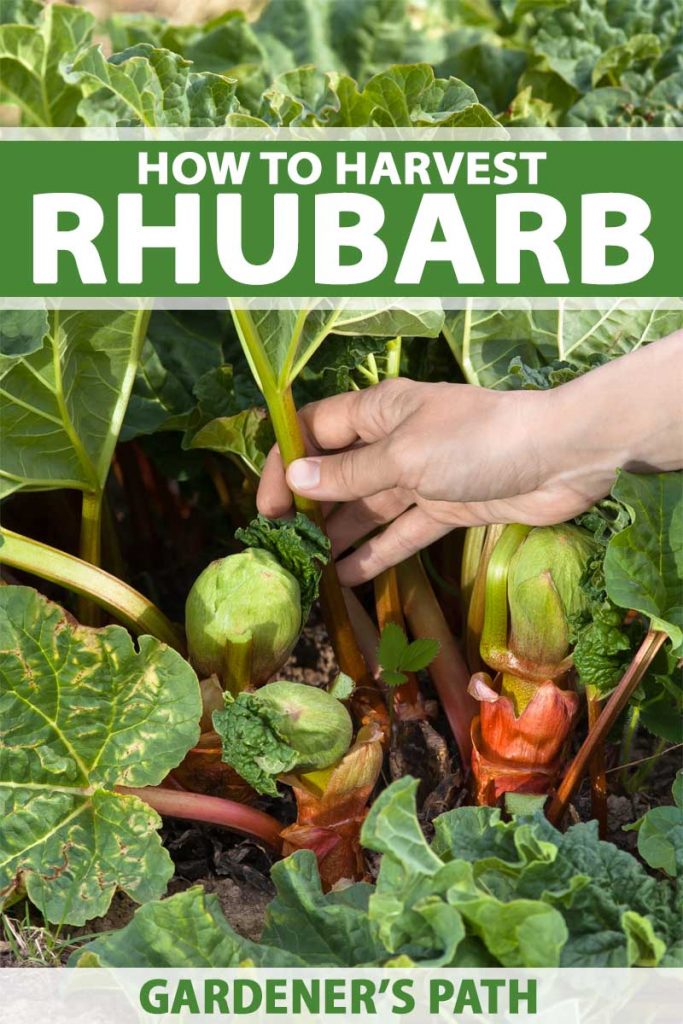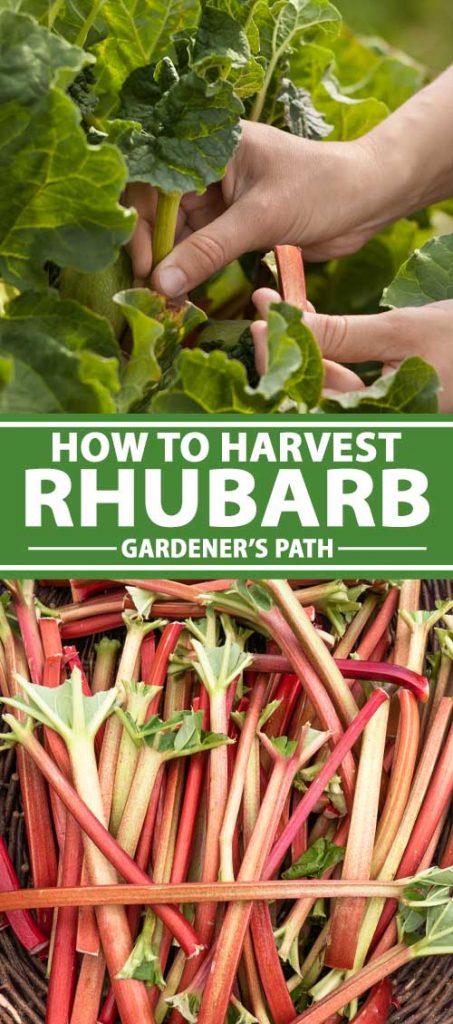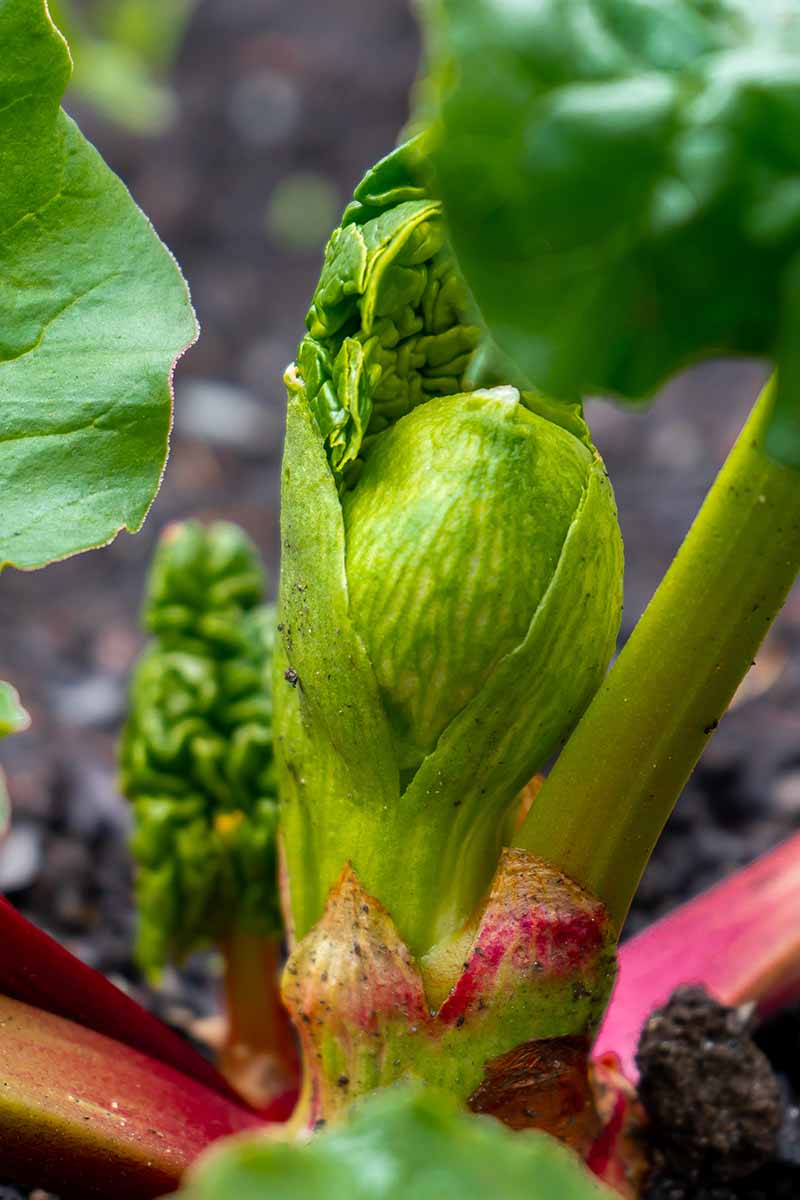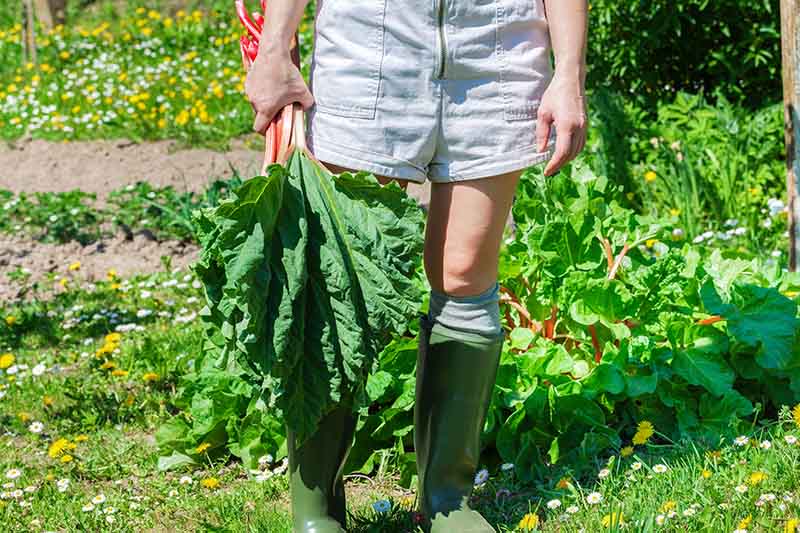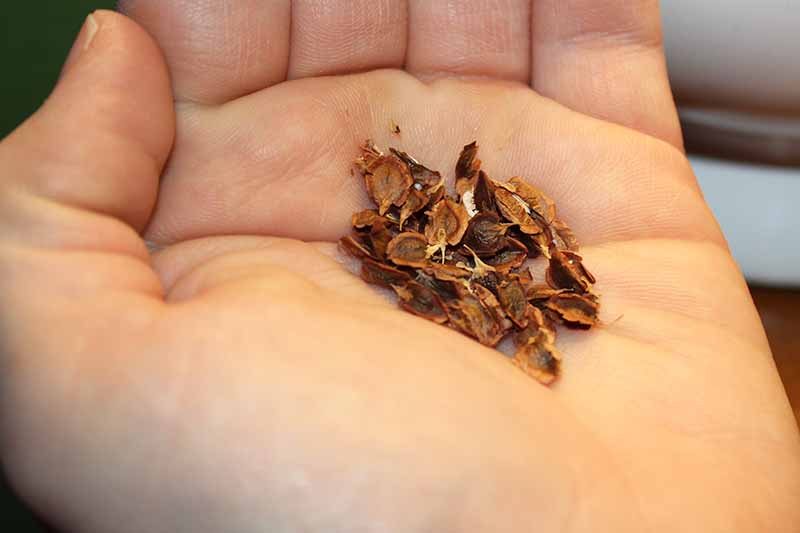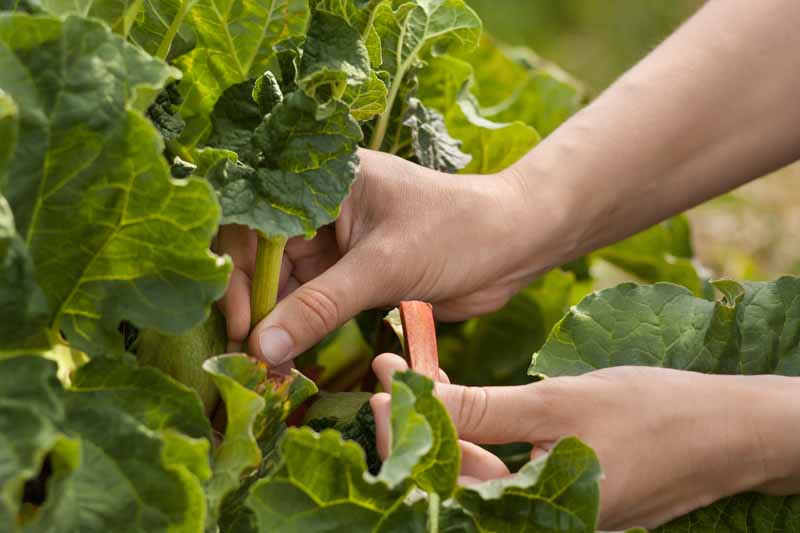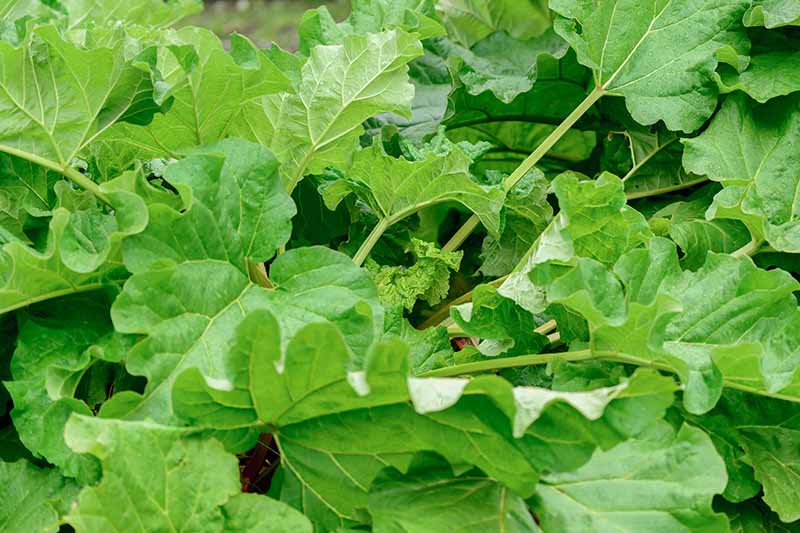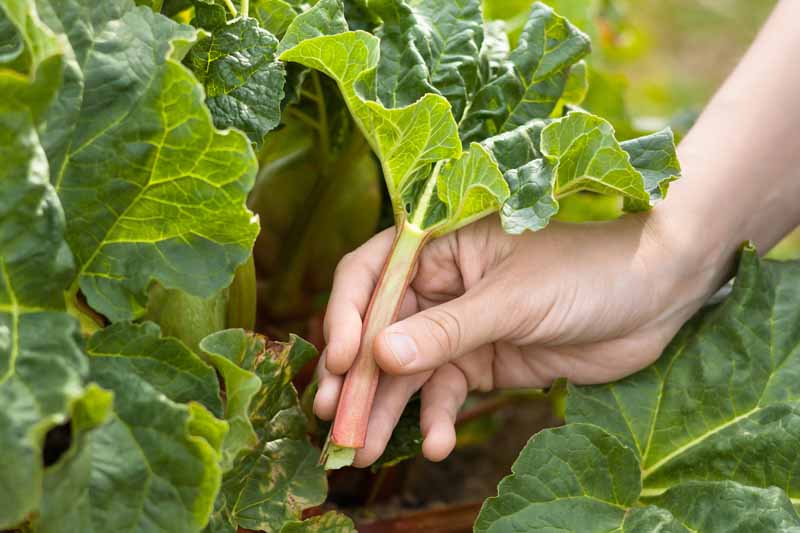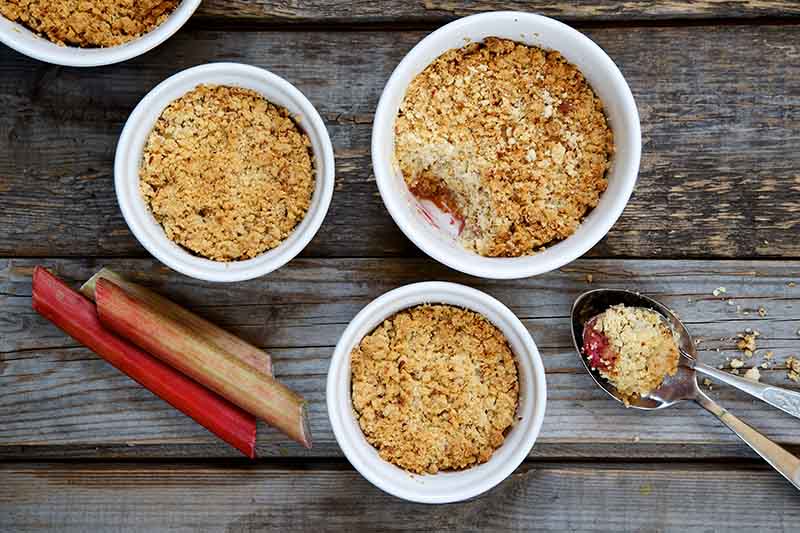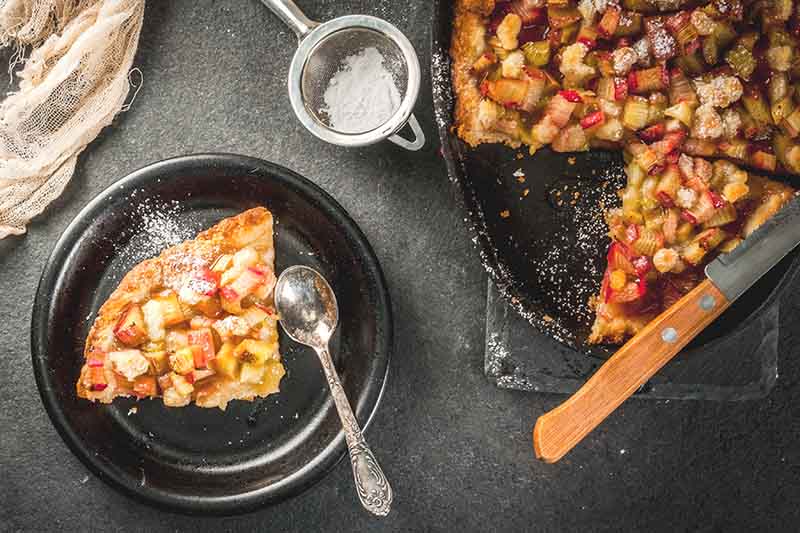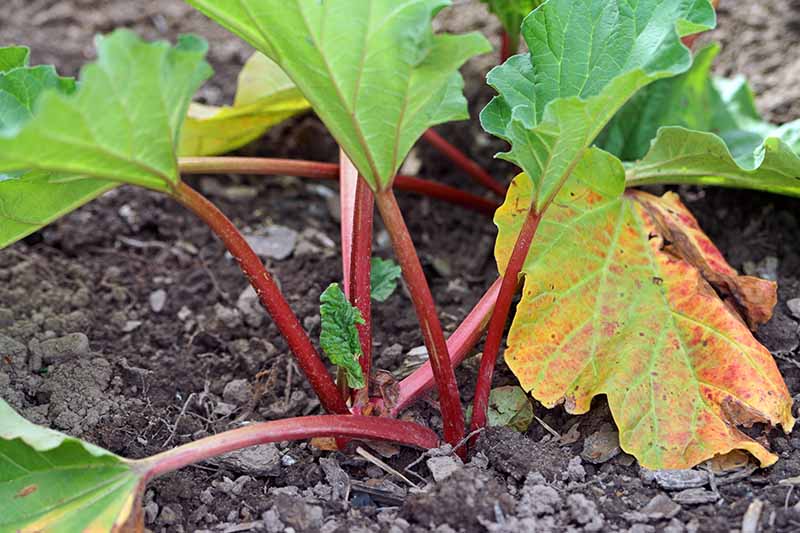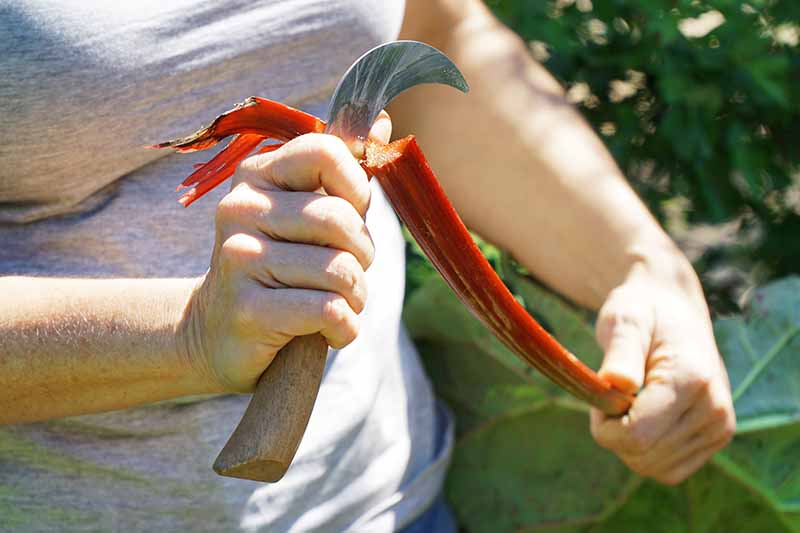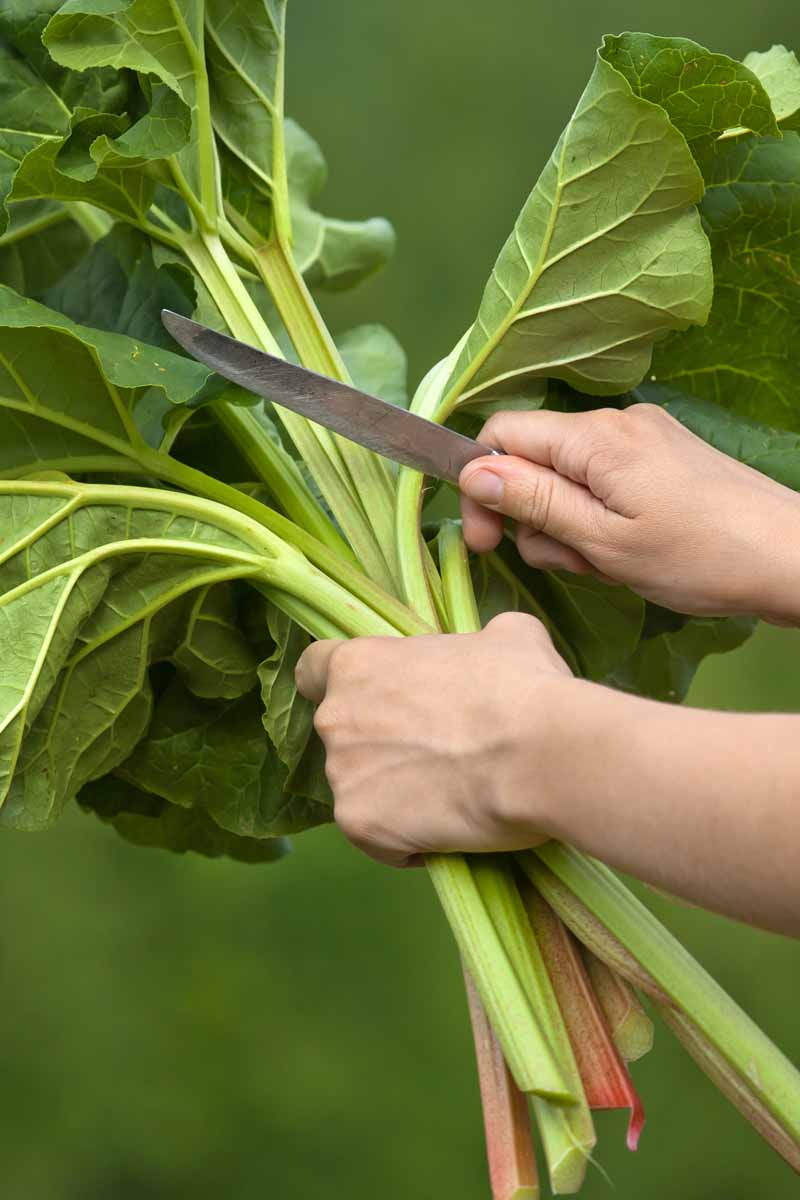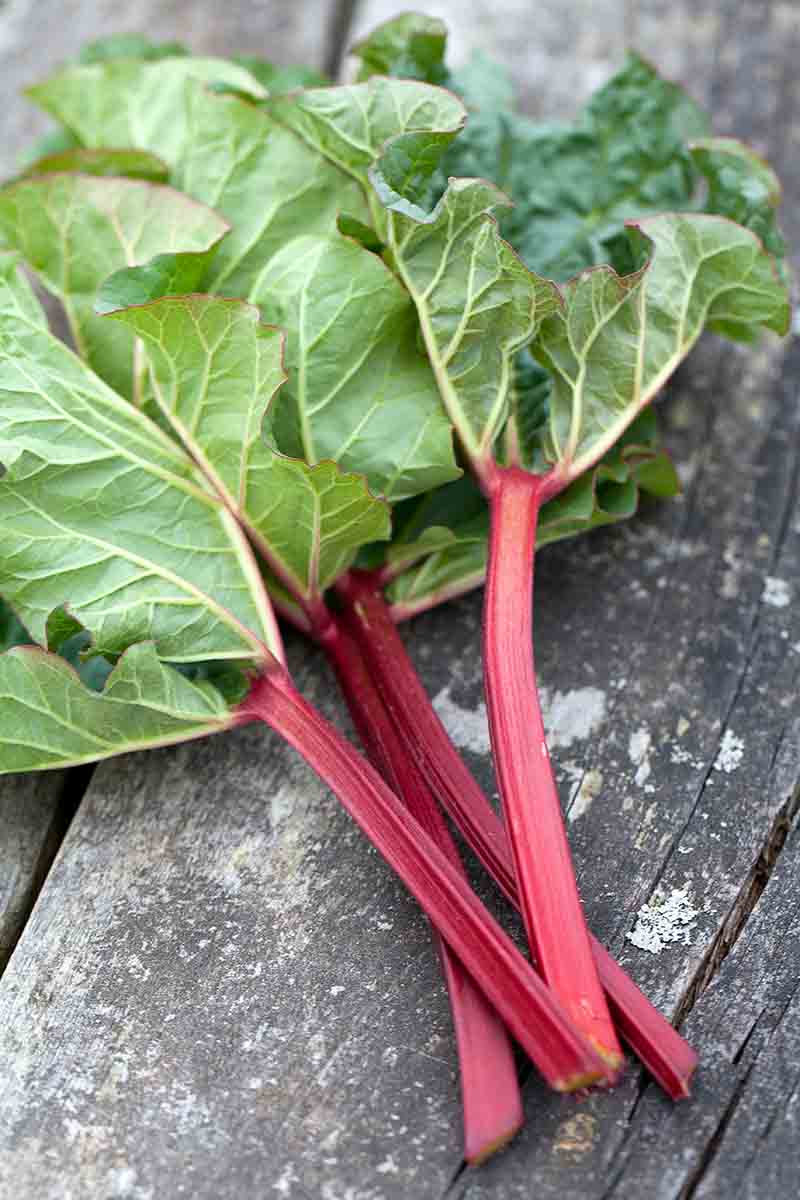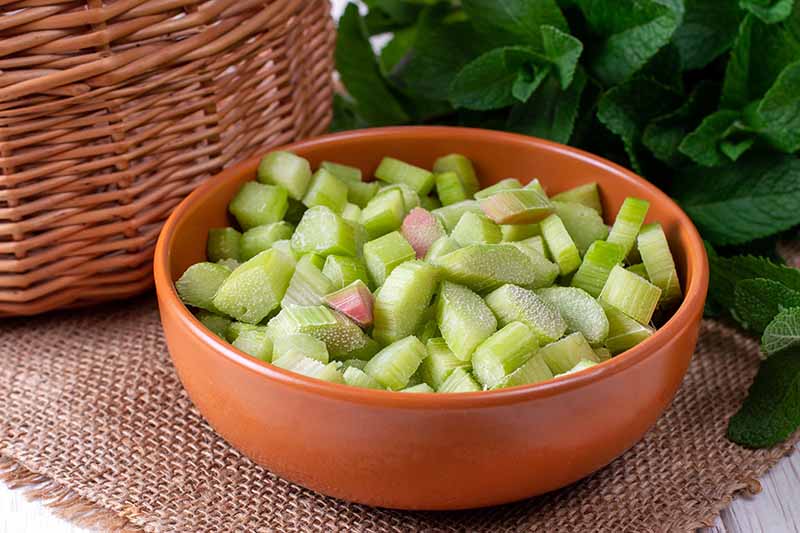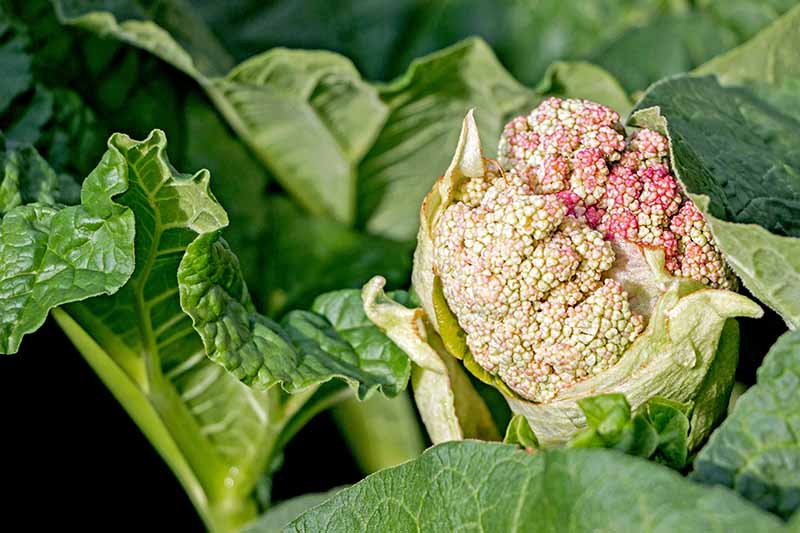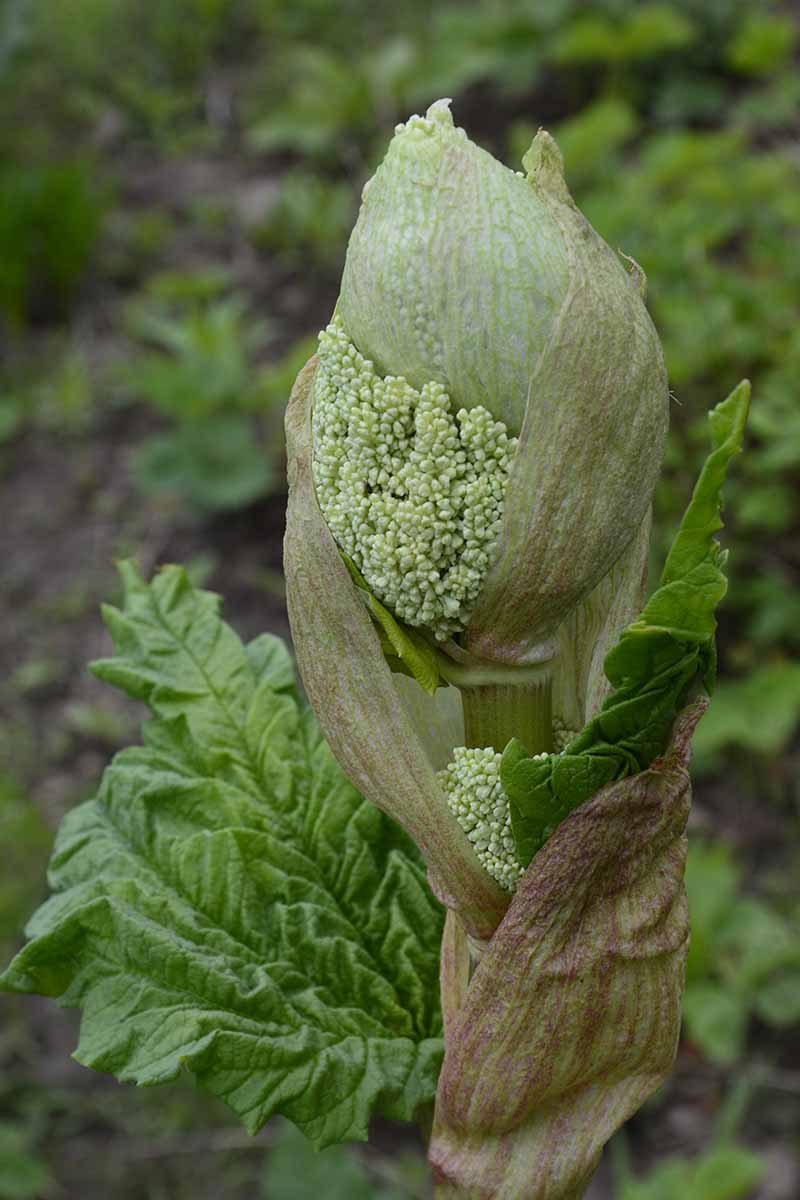Compared to something like a carrot, which you can enjoy just 60 to 75 days after planting, pie plant takes months. Often one year. Sometimes two or three. But oh, when you finally bite into that heavenly slice of rhubarb pie, crisp, or crumble, the wait will have been beyond worthwhile. This means that if you haven’t ever grown rhubarb before, you should start now. Check out our complete guide to growing rhubarb to get started. We link to vendors to help you find relevant products. If you buy from one of our links, we may earn a commission. Here’s what I’ll cover:
When to Harvest Rhubarb
There are many ways to plant: from seed, crown, bare root, or division. And you if you don’t have space in your garden, you can always grow rhubarb in containers. We cover this in more detail in our guide to rhubarb varieties. But each planting method has different harvest specifications, so let’s find out what that’s all about.
From Divisions: The Quickest Way to Home-Grown Stalks
Divisions are taken from rhubarb plants that are either about to go dormant for the winter, or about to leave the days of dormancy behind. If you’re lucky enough to score a division from a friend, you’ll get to enjoy your own tart stalks come springtime.
This is because divisions are already mature plants that will produce stalks easily. The yield depends on how large the root section is. (Hint: the larger it is, the more pie plant stalks you’ll get to harvest!) So don’t be shy. Ask your rhubarb-laden gardening friends if you can take a nice chunk home to your own garden.
You’ll know stalks are mature when they’re at least 12 inches long. Don’t worry about the color: a green stalk does not mean the plant isn’t ready. It simply means you chose a green-stalked variety, like ‘Victoria’ often is, or ‘Riverside Giant.’ So all you need to know for now is this:
When planting from divisions, you can harvest stalks the first season
Bare Root: The Second-Fastest Way
A bare root is basically a dormant division purchased from a nursery and it’s usually a lot smaller than a division you’d get from a friend. For this reason, it’s best to leave bare roots alone during their first season after you plant them. They’ll produce stalks, but the plants are small and often a lot younger than the massive spread in your friend’s garden. You can begin to lightly pick rhubarb planted from bare roots in the second season, and pick regularly the third season after. To make it easy to remember, here’s the key point:
Bare root rhubarb should be left alone the first season after planting, lightly harvested the second, and harvested normally from the third season
From a Crown: Also the Second-Fastest Way
A crown is a small plant that’s at least a year old. You’ll often find these in your local nursery, chilling out in the planters where they were born, ready for transplant into your garden.
While you can technically tug one or two slim, short stalks from your plant the day you bring it home, it’s best to leave it alone for a full year after planting. This gives it the time to get established. In the second season after you plant it, go ahead and take 1/4 to 1/3 of the stalks if your plant looks robust. By the third season, you’ll be able to pick 1/2 to 3/4 of the tasty petioles. To sum it up…
Crowns are potted plants that are at least a year old. Harvest lightly in the second season after planting, and regularly in the third.
Sowing Seeds: The Slowest Way
It may be two to three years before you get to pick rhubarb planted from seed, but don’t knock this method completely because it is fun. Here in Alaska, I’m used to seeing huge clumps of rhubarb all over the place come summertime. But when I start pie plant from seed, I get to watch the transformation from papery seed, like this: To four-week-old seedling, like this, and beyond: Isn’t it miraculous that this tiny plant grows up to four feet tall and wide, depending on the variety? That the humble stalks become the dazzling star of so many sweet dishes? Call me strange, but I feel a bond with these little plants. I’ve known them for so long, and once they’re planted against my red barn, I’ll smile and remember when I held them in my palm in seed form. Think of planting from seed like planting from a crown but with an extra year or so tacked on. You’ll need to wait until the seedlings become crowns, and then another year until the crowns produce big enough stems for very light picking (1/4 or less of the plant). By the third year, you can take 1/3 to 1/2 of the stalks. By the fourth, you’ll be able to take a regular picking of 1/2 to 3/4 of the total petioles. For a quick recap, seed-sown rhubarb needs:
Two years from germination until you can pick very lightly; three years for a light harvest; four years for a normal harvest.
What Time of Year to Harvest
No matter which planting method you choose, the actual months of harvest season remain the same. It all depends on your USDA Hardiness Zone. In the Pacific Northwest, Alaska, and the Midwest –ƒ Zones 2-6 – you can typically pick rhubarb all the way from April to early July. Take the first harvest when stalks mature in April, leaving 1/2 to 3/4 of the petioles intact.
After another month or two, new petioles should have grown to replace the ones you harvested. Again, take 1/2 to 1/4 of the petioles, leaving the rest. For the rest of the summer, allow the plant to grow untouched. This will help it store up nutrients for winter sustenance, ensuring that you get a healthy crop the following spring.
In Zones 7 and 8, winters are milder. You’ll be able to get your plants in the ground sooner, and they’ll mature more quickly. Pick from March through May in these Zones, leaving the plants alone in their hopefully semi-shaded area to weather out the rest of the summer and store energy for the winter.
Picking time is even earlier if you’re growing rhubarb as an annual in Zones 9 or above. You’ll have sown seeds indoors in August and planted them (or potted crowns) outside by October. In this case, you can pick them from about February to April. Take just 1/4 of the stalks earlier in the season, leaving the rest behind to get stronger and bigger. But in April, go ahead and harvest every single stalk. After April, your plants will probably perish in the summer heat. And you’ll start the process all over again in August. Same thing goes for those who plant divisions or bare roots, although this can be problematic in warm climates as root rot easily takes hold of the plants if the soil becomes too hot. To sum up harvest times by Zone:
Zones 2-6: Harvest from April to early July Zones 7 and 8: Harvest from March to May Zones 9 and Up: Harvest from February to April
Best Time of Day to Harvest
I have visions of heading out to my cool, early-summer garden in the morning and plucking stalks for my breakfast crumble.
Or weaving my hand through the plant to find the juiciest petioles in the evening for a spur-of-the-moment pie. But the truth is, you can pick rhubarb at any time of the day.
It may prefer being plucked away from its mother plant in the cooler hours of the morning or evening, but stalks won’t lose their crispness if you pick them in the heat of the day – as long as you bring them indoors right away.
Knowing When Stalks Are Ready
Still worried about how to know when stalks are ripe and ready? All you need to remember is that they should be at least 12 inches long. It’s also nice for your plant if you wait until there are about 10 stalks on a plant, so that when you harvest about 1/4 to 1/2, at least 5 to 7 stalks remain.
Here’s the rule to follow: if your plant has fewer than 10 petioles but they are all ripe, harvest no more than two to four. It helps if you have several plants from which to take one or two stalks apiece, leaving the rest to grow for a while longer before you collect again later in the season.
How to Harvest
The only tools you need are your own two hands. While you can technically use a garden knife, stalks are often so close together that you might accidentally slice into a petiole you didn’t mean to nick.
If you do choose to use a knife, find the bottom of the petiole with your hand, pull it away from the other stalks, and gently cut downward. Or, take the easier and safer route of simply gripping the middle of the stalk with both hands and then twisting and pulling at the same time. The end of the stalk will have a tapered, papery portion.
Go ahead and cut that off.
While you’re at it, snip the leaves off, too, and take them to your compost pile – or the garbage. Just make sure they stay out of reach of children and animals, as the leaves are toxic.
Preserving Stalks
By the time three or four years have passed since you first planted rhubarb, you’ll have so much that you probably won’t be able to use it all at once.
Freshly picked rhubarb will stay fresh in the refrigerator for about a week as long as it’s kept in a zip top bag or other airtight container. If you just stick it in the fridge as is, it’ll dry out. To keep rhubarb around even longer, freeze it!
All you have to do is slice the stalks into one-inch pieces, set them on parchment paper, and place them in the freezer until they’re firm. Then move them to date-marked freezer bags, where they’ll keep in your freezer for up to a year.
What To Do If Rhubarb Bolts
You can usually catch seed heads before they turn into full-on flowers. They’ll usually emerge from the base of the plant, green and bulbous. The stalks that seed heads grow on are usually tougher than edible stems, so you’ll need to take a sharp knife and cut them as close to the base of the plant as possible.
This is the case whether you catch the seed head in its early stages or you end up needing to remove a tall stalk with several seed heads.
If you let your plant go to flower, the edible stems will taste the same and your plant will still live for many more years. But since all the energy is poured into creating seeds, you won’t get to pick nearly as many stalks.
And if you need further inspiration, our sister site, Foodal, has plenty of ideas for what to do with your fresh harvest. We’d love to know: what’s your favorite rhubarb treat? Mine, of course, is pie. But when my seedlings turn into big strong plants and I get to harvest homegrown stalks, you bet I’ll be trying every recipe I can find. Let us know in the comments if you have any extra harvesting tips we should know about, and what you plan to do with your freshly harvested pie stalks! If you’re thinking about adding more vegetables to your garden you’ll need these guides next:
How to Plant and Grow Swiss Chard How to Grow Cauliflower, a Challenging Cool-Weather Crop How to Grow Bok Choy
Photos by Laura Melchor © Ask the Experts, LLC. ALL RIGHTS RESERVED. See our TOS for more details. Originally published on March 2, 2020. [lastupdated]. Uncredited photos: Shutterstock. With additional writing and editing by Clare Groom and Allison Sidhu.
